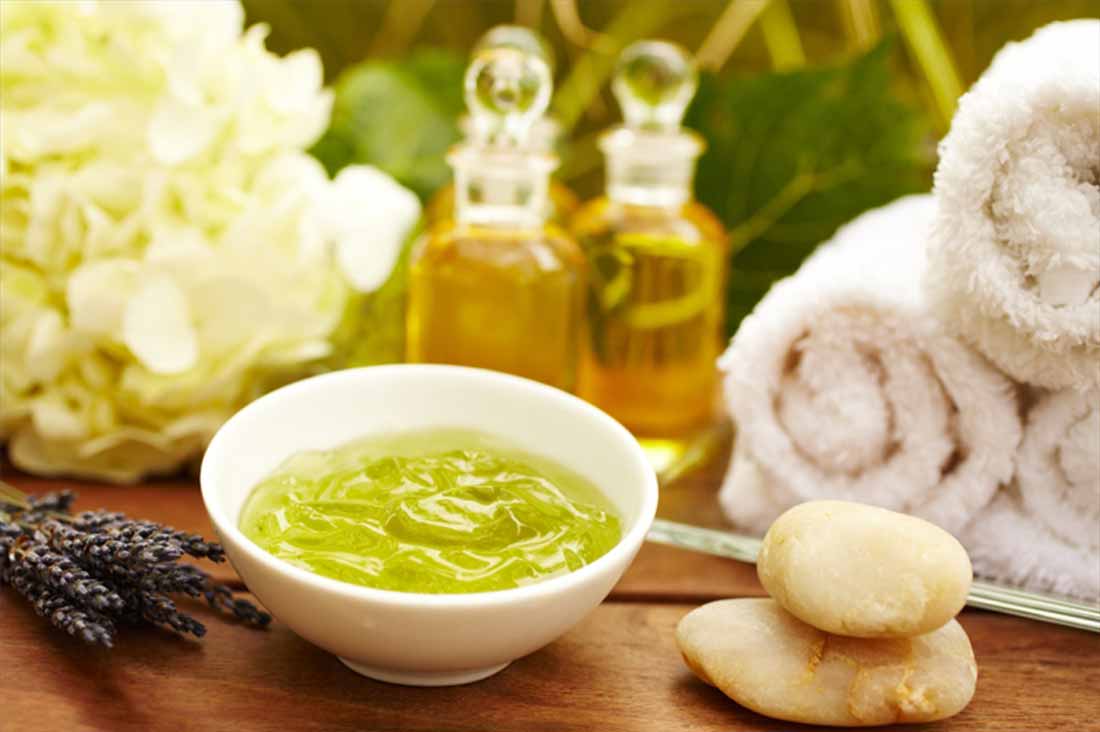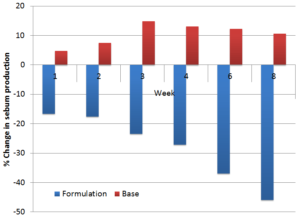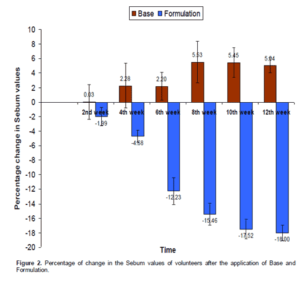Oily skin is a hassle for most acne patients. Studies show acne-prone skin produces 3 times more sebum than healthy skin. This creates ideal conditions for clogged pores and acne causing bacteria. Luckily for all of us with greasy skin, research is starting to deliver results.
In earlier posts I’ve talked about topical treatments that can reduce sebum production. Recently I came across other studies, and in this post I want to talk about those and what do they mean for you. I for one can’t be rid of my oily skin too soon.
How topicals can reduce sebum production
Before I get to the studies let me first briefly explain why these creams work. Just so you are familiar with the terminology. Studies have shown that acne responds to androgens (male sex hormones), this is due to genetics. Many studies show higher androgen levels in acne patients than in healthy controls, and suppressing androgen receptors in the skin reduces both sebum production and acne.
An enzyme known as 5-alpha reductase (5-AR) plays a part in this puzzle. The enzyme converts testosterone to DHT, which stimulates sebum production and skin cell growth more than other androgen hormones. At least some studies show that 5-AR is overactive in acne patients. I should also note that the conversion of testosterone to DHT happens in the skin.
By inhibiting 5-AR enzyme we can also inhibit the conversion of testosterone to DHT and thus reduce sebum production, skin cell growth and eventually also acne. Several substances inhibit 5-AR, such as EGCG in green tea, certain fatty acids, zinc and saw palmetto.
We can’t say for sure, but 5-AR inhibition is the most likely explanation for the results in the studies below.
Saw buckthorn slashes sebum production by 45%
The first study was done by researchers at the Islamia University of Bahawalpur, Pakistan. They studied the effect of 1% sea buckthorn cream extract cream on sebum production. In this study they used 10 male volunteers aged between 20 and 35 years, and gave each participant either the treatment cream or a placebo cream that didn’t contain the plant extract.
Basically they made the treatment cream by first making a ‘vehicle base’ (that takes the active ingredients into the skin) and mixing the plant extract into the base. The placebo cream was just the base.
They asked the participants to apply the treatment cream to one side of the face and the placebo cream to the other side. This is known as split-face study design.
This chart shows the results, % reduction in sebum production over 8 weeks.
Source: Formulation and evaluation of antisebum secretion effects of sea buckthorn w/o emulsion
There was a steady decline in sebum production in the side treated with sea buckthorn cream. After 8 weeks sebum production had dropped by 45%. This is more or less in line with results from green tea and saw palmetto/sesame seed/argan oil studies.
Interestingly the side treated with base-only cream showed increase in sebum production. The researchers note that this change was not statistically significant, so it’s possible it was just due to the inherent randomness of measurements like these.
Capparis decidua extract reduces sebum production by about 20%
The other study also comes from the same university. This time they studied fruits from a desert plant Capparis decidua, commonly known as kerda or kair.
They made a cream with 5% extract of kair plant, I presume with plant they mean the fruit this bush produces. This study was very similar with the above study, a split-face design with treatment cream applied to one side of the face and base cream on the other side.
This graph shows the results, change in sebum production over time.
Source: Development of a sebum control cream from a local desert plant Capparis decidua. (PDF)
As you can see the treatment cream reduced sebum production by 18% after 12 weeks. This graph also shows what I’ve been saying over and over. It takes time for these creams to work. Notice the big drop in sebum production from week 4 to week 6, from about 5% to 12%.
As with the previous study the side treated with placebo cream showed an increase in sebum production (not statistically significant). Researchers speculate this could be because of the oils used in the base cream. Though I’m not sure how applying oil on the skin could increase sebum production.
And even more studies
As I was doing research for this post I also ran into a few other studies that showed reduction in sebum production. I’ll just mention these briefly as I didn’t have access to the full-text versions of the studies and they didn’t quantify reductions in the abstract.
- This study showed reduction in sebum production in women with progesterone cream but no effect in men. Progesterone is a hormone created by the ovaries during ovulation. It can suppress androgen levels and apparently also inhibits conversion of testosterone to DHT.
- Another study looked at black cohosh (Cimicifuga racemosa) extract cream on acne. After 8 weeks acne severity was reduced in all participants. This study used both males and females. Researchers speculate that reduction in acne was due to inhibition of 5-alpha reductase enzyme. Unfortunately it seems they didn’t measure sebum levels in this study.
- Finally, this paper talks about 2 studies done in France and Thailand evaluating Orthosiphon stamineus (apparently commonly known as cat’s whiskers, Java tea or Misai Kucing) on sebum production and skin appearance. Cream with 2% concentration of extract reduces sebum production, oily skin appearance and improved evenness of skin complexion.
Where to get
When I write about these studies somebody inevitable asks where to buy these creams. Unfortunately I don’t know. The researchers made the creams in a laboratory. If you have little bit of chemist in you (and have access to a lab) you can make them yourself, check the full-text studies for instructions.
Exposed Skin Care is the only commercially available product I know of that can reduce sebum production. They include green tea in all of their products and the moisturizer includes pumpkin seeds that contain fatty acids that inhibit 5-AR.
I used it for 2 months and had very good results with it, including noticeable reduction in oiliness of my skin. I would still keep using it but the Thai customs insist I need a license to import it and keep sending my orders back. Because of my own experience with it, looking at the ingredients and talking with the owner, I’m happy to recommend Exposed. So please try it out if you are struggle with oily skin. As a disclaimer, I do receive a small commission from Exposed if you buy after clicking from my website. The price you pay is the same and you help to support this website, and for that I want to thank you. Click here to learn more about Exposed.
Other than that you can look for moisturizers or creams that include 5-AR inhibiting ingredients (this page contains a list). Applying fresh green tea or evening primrose oil on your skin might also help, but I have no data to say for sure.
Conclusion
There’s a good case to be made for DHT as one of the causes of acne and inhibiting it as a way to treat acne. These studies add further support to it. Acne-prone skin is a bit too overenthusiastic in converting testosterone to DHT. This increase sebum production, skin cell growth and keratin levels in the skin cells (which causes them to lump together), all of which conspire to make a mess of your skin.
Several substances can inhibit the conversion, and studies show this can drastically drop sebum production. One study on green tea showed 70% reduction, sea buckthorn 45% reduction and a cream combining saw palmetto, argan oil and sesame seed extracts 42% reduction. Impressive results from all-natural products with little to no side-effects.
Now if only the cream manufacturers would catch up with research and actually make these creams. I know only of Exposed Skin Care line uses DHT-blocking ingredients in significant quantities.




not saying one way or the other about effectiveness but Neutrogena Spot Stress Control contains Green tea. I definitely have no interest in promoting this!
Hi Seppo .
Do you pay taxes/ duties to Thai customs when you import products from i herb?
I ask because I HERB shipping is cheap but i always pay duties ( more than half the cost of my products ) to Indian customs when ever i order products ( via your link).
It’s a bit random. Most of the time the packages pass customs without duties, but once I had to pay about 30% import duty. If I use DHL or other more expensive shipping method, then I have to pay duties every time. It doesn’t make much sense, but so it seems to be.